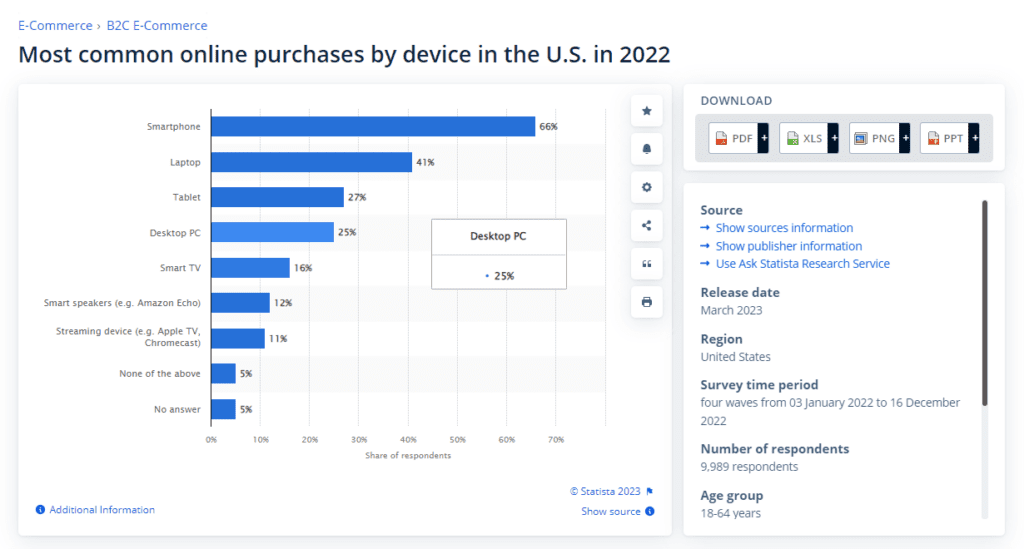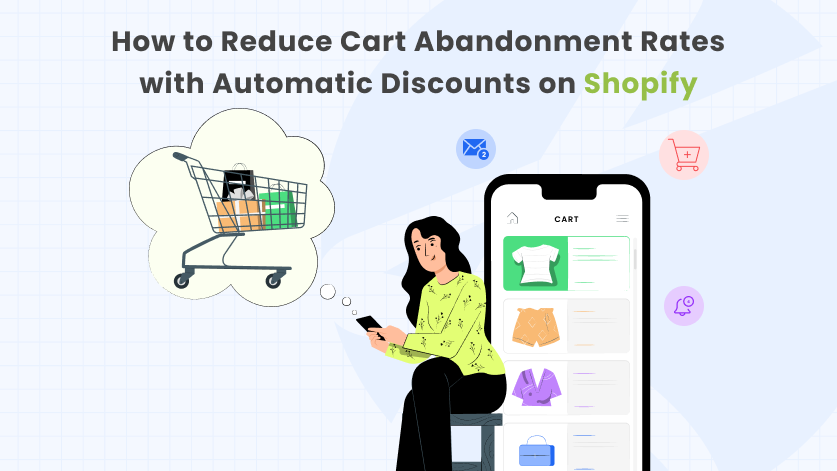In today’s competitive eCommerce landscape, reducing cart abandonment rates is critical for online businesses to maximize their revenue potential. Cart abandonment refers to the phenomenon where customers add items to their shopping cart but leave the website without completing the purchase. This can significantly affect sales and impact business growth.
To overcome this challenge, it is important first to understand the reason for cart abandonment and then implement effective strategies to reduce it.
According to Baymard Institute, the numbers show that 69.82% of online shopping carts are abandoned. This indicates that 7 out of every 10 customers add products to their cart and leave without purchasing.
The cart abandonment is estimated to cost $18 billion in lost revenue each year.
While some cart abandonment incidents may be attributed to impulsive or casual browsing, there are also situations where customers feel difficulties while purchasing online.
The good news is that it is possible to avoid this kind of cart abandonment. Businesses may increase lost sales and reduce cart abandonment rates by putting in place efficient solutions.
In this article, we’ll look at tactics for reducing eCommerce site cart abandonment and increasing conversions. While there are several ways to approach this problem, we will particularly concentrate on the effectiveness of automatic discounts.
You can encourage customers to finish their transactions, increase customer loyalty, and eventually reduce the cart abandonment rate by carefully utilizing automatic discounts.
Let’s dive into the practical tactics that can boost your eCommerce efficiency and help you recover your lost sales.
How to Calculate Abandonment Rate?
Calculating the abandonment rate is a valuable metric for businesses to assess the effectiveness of a particular process or customer journey.
Abandonment rate refers to the percentage of cases, transactions, or actions that are initiated by users or customers but left unfinished or abandoned before completion.
This metric provides insights into the number of individuals who did not proceed or complete a desired action. To calculate the abandonment rate, you need to determine the number of abandoned cases or transactions and divide it by the total number of initiated cases or transactions.
The result is then multiplied by 100 to express it as a percentage. By monitoring and analyzing abandonment rates, businesses can identify potential issues, bottlenecks, or areas for improvement in a specific process.
This information enables them to take targeted actions to optimize their processes, reduce abandonment, and enhance customer satisfaction.
Let’s say you want to calculate the abandonment rate for the checkout process on an eCommerce website. During a specific time period, you had a total of 1,000 initiated checkouts. Out of those, 250 customers abandoned their carts before completing the purchase.
To calculate the abandonment rate, you can use the formula:
Abandonment Rate = (Number of Abandoned Checkouts / Total Number of Initiated Checkouts) x 100
Plugging in the values from the example:
Abandonment Rate = (250 / 1,000) x 100 = 25%
In this scenario, the abandonment rate for the checkout process on the eCommerce website is 25%. This means that 25% of customers who started the checkout process left without completing their purchase.
Most Common Shopping Cart Abandonment Reasons:
Understanding the most common reasons behind shopping cart abandonment is crucial for businesses to increase conversion rates and optimize the overall customer experience.
By identifying the most common reasons that lead customers to abandon their shopping carts, eCommerce businesses can take targeted actions to these issues and enhance their chances of securing completed transactions.
Let’s explore some of the most common shopping cart abandonment reasons:
- High Shipping Costs: Unexpectedly high shipping costs during the checkout process can significantly deter customers from completing their purchases. Additional fees, taxes, or shipping charges that were not clearly communicated upfront can create frustration and lead customers to abandon their carts.
- Complicated Checkout Process: A complex and lengthy checkout process is another major culprit behind shopping cart abandonment. If customers are required to go through multiple steps, create an account, or provide excessive information, they may feel overwhelmed or find it time-consuming, leading them to abandon the purchase.
- Security Concerns: Online security is a top priority for customers. If an eCommerce website does not provide a secure and trustworthy environment for transactions, customers may not enter their sensitive payment information, ultimately abandoning their shopping carts.
- Lack of Guest Checkout Option: Requiring customers to create an account before purchasing can be a significant barrier. Some customers prefer a quick and hassle-free checkout experience without the need to create an account. By not offering a guest checkout option, businesses may lose potential sales.
- Limited Payment Options: Customers have diverse payment preferences. If an eCommerce website offers only a limited range of payment options, such as not accepting popular digital wallets or alternative payment methods, it can lead to cart abandonment as customers seek more convenient payment options.
- Unexpected Additional Costs: Surprises at the final stages of the checkout process, such as additional taxes, handling fees, or upsells, can catch customers off guard. Unclear or undisclosed additional costs can create a sense of mistrust and prompt customers to abandon their shopping carts.
- Lack of Trust and Social Proof: Testimonials, reviews, and social proof play a vital role in building trust with potential customers. If an eCommerce website lacks product reviews, trust seals, or credible endorsements, customers may hesitate to proceed with their purchase, resulting in cart abandonment.
- Technical Glitches and Website Performance: A poorly optimized website with slow loading times, frequent errors, or technical glitches can frustrate customers and cause them to lose trust in the platform. If the checkout process is hindered by such issues, customers are likely to abandon their carts and look for a more reliable alternative.
- Lack of Mobile-Friendly Experience: Mobile devices play a significant role in online shopping. If an eCommerce website does not offer a seamless and user-friendly mobile experience, such as a responsive design or a dedicated mobile app, customers may find it challenging to navigate the site and complete their purchase, leading to cart abandonment.
By understanding these common cart abandonment reasons and the corresponding statistics, businesses can implement targeted strategies to mitigate cart abandonment and increase conversion rates.
How to Optimize Your Store to Reduce Shopping Cart Abandonment:
- Simplify the Checkout Process: Streamline the checkout process by reducing the stages and form fields that must be filled out. As stated above, a drawn-out or challenging checkout procedure can result in desertion, with 28% of customers identifying it as a cause.
- Provide Guest Checkout Option: Offer a guest checkout option so that clients can complete their purchases without creating an account. By doing away with the necessity for extra steps, the checkout procedure may become less tense.
- Improve Website Performance and Speed: Slow-loading websites can annoy visitors and make them leave. To ensure a quick and effective browsing experience, make sure your website is optimized for speed and efficiency.
- Enhance Mobile Responsiveness: It is essential to have a mobile-responsive website given the rise in the use of mobile devices for online shopping.
According to a Statista survey, mobile devices accounted for 66% of all eCommerce purchases completed in the US. You may cater to the increasing number of mobile shoppers and lower cart abandonment by optimizing your store for mobile.

10 Strategies on How to Reduce Cart Abandonment with Automatic Discounts on Shopify:
Automatic discounts on Shopify may be an effective technique for deterring cart abandonment and encouraging customers to complete their transactions.
By carefully utilizing automated discount tools like AIOD – All Automatic Discount, businesses can significantly lower cart abandonment rates and boost conversions.
Here are 10 strategies to think about with discounts:
Strategy #1: Exit-intent Popups with Automatic Discount Offers:
An exit-intent popup can be activated when a customer shows indicators of leaving the website and offers them a discount right away. This tactic seeks to grab their interest and give them a reason to stay and make a purchase.
If you want to create a discount code popup to attract customers and reduce cart abandonment, here is a complete guide on Shopify discount code popups.
Strategy #2: Abandoned Cart Recovery Emails with Dynamic Discount Codes:
Re-engaging clients who abandoned their baskets can be accomplished by sending automated cart abandonment emails with dynamic discount codes. These emails serve as a gentle reminder to customers to finish their purchases while also offering them a unique discount coupon.
According to SaleCycle reports that the average conversion rate for abandoned cart recovery emails with discounts is 31.81%.
Strategy #3: Time-limited Discounts for Cart Recovery:
Creating a sense of urgency might encourage clients to act right away. You can encourage customers to complete their purchases by providing time-limited incentives for cart recovery, such as a 24-hour promotion or restricted product availability.
This tactic, which takes advantage of people’s FOMO (fear of missing out), can significantly reduce the cart abandonment rate.
For example: Display a countdown timer alongside the automatic discount to motivate customers to complete their purchase before the offer expires.
Strategy #4: Tiered Discount Offers Based on Cart Value:
Customers may be encouraged to add more goods to their carts by implementing tiered discount offers based on the cart value.
For example: You may provide discounts of 5% for orders under $50, 15% for orders between $50 and $100, and 20% for orders over $100.
By encouraging customers to place larger orders in order to receive greater discounts, this tactic lowers the possibility that they will leave their shopping carts empty.
Strategy #5: Free Shipping Threshold with Automatic Discount at Checkout:
Shipping expenses that weren’t anticipated are among the most frequent causes of cart abandonment. You can encourage customers to add more goods to their carts by defining a free shipping threshold and offering an automatic discount at checkout to meet that threshold.
When the cart value exceeds $100, for instance, you might immediately apply a 10% discount code and provide free shipping for orders over $100. This tactic increases average order value while reducing the shopping cart abandonment rate.
Strategy #6: Automatic Discounts for Returning Customers:
Rewarding your loyal customers can promote loyalty and increase repeat orders. You foster a sense of appreciation and value by providing automatic discounts only to loyal clients.
For instance, you might offer them a 15% discount on their second purchase or set up a tiered loyalty program with discounts that increase sales of your store.
This approach fosters long-term consumer relationships while simultaneously lowering shopping cart abandonment rates.
Strategy #7: Cross-selling and Upselling with Automatic Discounts:
Cross-selling and upselling strategies can increase average order values while lowering shopping cart abandonment rates. You can encourage customers to add more things to their carts by providing automatic discounts on additional or upgraded products when they are checking out.
For example: If a customer adds a camera to their cart, you can suggest to them that if they buy camera accessories, they will get a 20% discount.
Strategy #8: Provide Discounts for First-Time Customers:
The growth of a company depends on acquiring new customers and offering first-time customers automatic discounts can be a strong incentive. Presenting a unique discount or offer to customers who are making their first purchase can encourage them to finish the transaction and establish a positive first impression. You might offer your first customer a 10% discount or throw in a free present with their purchase.
For example: While lowering the likelihood of cart abandonment, this strategy increases the likelihood of customer retention.
Strategy #9: Referral Program with Automatic Discount:
Implementing a referral program with an automatic discount can be a powerful strategy to grow your business and increase customer loyalty.
By leveraging the power of word-of-mouth marketing and incentivizing your existing customers to refer their friends and family, you can tap into a valuable network of potential new customers.
You establish a win-win situation by giving automatic discounts to both the referrer and the referred customer.
For example: You may offer the referrer a 15% discount on their subsequent purchase and the referred consumer a 10% discount on their initial purchase.
Through word-of-mouth advertising, this tactic not only decreases the cart abandonment rate but also grows your consumer base.
Strategy #10: Dynamic Pricing Based on Cart Contents and Customer Behavior:
Dynamic pricing refers to changing prices in real-time based on a variety of variables, including the contents of the shopping cart, customer behavior, demand, or supply.
You can automatically give customized discounts or prices depending on particular criteria by empowering data analysis.
For example: If a customer has browsed a given product category for a predetermined period of time, you can offer a time-sensitive discount or a discount on more items if the customer’s basket value is about to cross a predetermined threshold.
By displaying personalized offers, this tactic improves the buying experience, boosts consumer engagement, and decreases the shopping cart abandonment rate.
Conclusion:
In conclusion, lowering cart abandonment is a crucial objective for eCommerce companies, and automatic discounts can be an effective abandoned cart recovery strategy in doing so.
In this article, we looked at a number of ways to use automatic discounts to reduce cart abandonment. Businesses can successfully reduce cart abandonment rates and increase conversions rate by understanding the causes of abandonment, improving the shopping experience, and applying focused marketing strategies.
Whether through exit-intent popups, abandoned cart recovery emails, time-limited discounts, or other tactics mentioned, automatic discounts provide a strong incentive for users to complete their purchases. Customers receive immediate satisfaction and value from them, which allays their worries and encourages them to complete their purchases.
It is vital to take action and improve your cart recovery strategies as an eCommerce company. Your cart abandonment rate can be greatly lowered and your business’s overall success increased by using automatic discounts.
You may increase customer loyalty, recover lost sales, and eventually drive revenue growth by utilizing the tactics covered in this article and continually reviewing and improving your abandoned cart recovery strategy.
Our professionals at Cirkle Studio are available to help if you need advice or direction with creating automated discounts or maximizing your abandoned cart recovery tactics. Please feel free to get in touch with us if you want professional guidance and assistance on lowering cart abandonment and improving your Shopify store success.
Don’t let abandoned carts get in the way of your success. Act now and benefit from automated discounts’ ability to reduce cart abandonment rates.








